Valkyrie (PG-13)
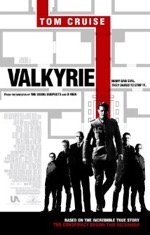
Starring: Tom Cruise
December 2008
“Riveting Slice of WWII History Hits Its Target”
A decorated, raven-haired soldier walks into a room filled with debating officers, surreptitiously places a handbag under the conference table and slowly backs out of the room. A few minutes later, the building explodes behind the escaping soldier. Inside the burning building are the strewn bodies of the chancellor and his top military advisors. Hitler is dead!
Sounds like a fictional story, right? Like they say, truth is often stranger than fiction. In reality, the above incident, dubbed Operation: Valkyrie, was just one of several failed assassination attempts made on the fuhrer’s life. The new movie based on this pulse-pounding chapter in World War II history is titled Valkyrie and is directed by Bryan Singer (X-Men).
The soldier in charge of the Valkyrie mission was Colonel Claus von Stauffenberg, a German officer with divided loyalties, willing to risk it all in order to end the tyranny of the 3rd Reich. In the movie, Stauffenberg is played by Tom Cruise, a dubious choice at first mention but a casting coup upon further reflection (take a look at the astoundingly similar side-by-side profile photos of Stauffenberg and Cruise at this film’s wikipedia page). Cruise, known for action roles more than psychological dramas, turns in a fine performance as the conscience driven soldier who can no longer stand by and allow Hitler’s atrocities to continue unimpeded. Cruise is surrounded by a dizzying array of A-list talent that’s essentially a who’s who of accomplished British actors, including: Kenneth Branagh, Bill Nighy, Tom Wilkinson, Terence Stamp, Eddie Izzard and Bernard Hill.
Although the set-up is a tad slow at times, the story starts to snowball once the assassination plot is formulated and set into motion. There’s a good deal of political intrigue and nail-biting suspense throughout, and the execution of the plan is an exercise in high anxiety. There’s bound to be a Murphy’s Law factor to any set of “best laid plans,” but the stakes here are impossibly high for Stauffenberg and his fellow conspirators: failure is tantamount to death. The drama reaches edge-of-your-seat intensity when the mission starts to unravel and Stauffenberg is forced to make choices that will eventually seal his fate.
A few months before seeing this film, I watched a documentary on the subject entitled Operation Valkyrie: The Stauffenberg Plot to Kill Hitler. With the accurate details of the actual mission fresh in mind from this presentation, I went into the movie expecting to find the usual fact fudging or creative embellishments that accompany far too many big screen adaptations of true historical stories these days. I must admit to being impressed and pleasantly surprised by Singer’s and writing duo Christopher McQuarrie and Nathan Alexander’s painstaking adherence to the recorded facts from the real-life account.
Singer’s attention to historical accuracy also extends to the movie’s finely mounted production elements, which populate every inch of the big screen in Valkyrie. Sets, props and costumes are all period appropriate and draw the audience into Stauffenberg’s world with their authenticity; noticeable flaws or inconsistencies would similarly take the audience out of the movie’s mesmerizing action. The virtually identical reconstruction of the Wolf’s Lair sets is awe-inspiring and many of the scenes in Berlin and the German forest were shot at the exact same locations where the actual events took place.
It’s a testament to the arresting events of the factual story that it can so effectively sustain viewer interest throughout its two hour running time. Likewise, it’s a testament to Singer’s unwavering vision—which has realized the Stauffenberg plot in exacting detail while also adding the visual urgency and narrative expediency befitting a big screen adaptation of such a crucial chapter of WWII history—that the story works at all in its cinematic form. Those who go in expecting all-out action (and the casting of Cruise is certainly disingenuous on this account) will surely be disappointed by this psychologically and politically complex docu-drama, but for those who can sit through the denser intrigue in favor of its suspenseful action scenes will find a film that educates while it entertains. If only there had been more men of conviction like Stauffenberg to stamp out the evil and injustices committed in our generation. If only…
Rating: 3
Marley & Me (PG)

Starring: Owen Wilson
December 2008
“Heartwarming, Tear-jerking Dramedy is a Doggone Good Time”
John Grogan (Owen Wilson) is wading through the deep stuff. His wife, Jenny (Jennifer Aniston) wants to have a baby. John turns to his friend, Sebastian (Eric Dane), for advice and is told that the best way to slow down Jenny's biological clock is to sidetrack her with a puppy.
For her birthday, John buys Jenny a puppy...the cheapest of the litter, which should automatically raise a caution flag in one's mind. Of course, as the story would require, the little mutt grows at an alarming rate and soon takes to ransacking the Grogan house and generally making its owners’ lives a living nightmare. And of course, it's not too long before Jenny gets pregnant, leaving John to wonder where his well-calculated plan went so awry.
Marley & Me, based on the experiences of the real-life Grogan family, is fairly believable, but there are a few moments of hyper-reality. Thankfully, these requisite mishaps involving the calamitous canine don't degenerate into the kind of improbable silliness that reigned supreme in the Beethoven movies. Such paint-spilling, car-denting, villain-foiling antics would have killed this movie as sure as rabies killed Old Yeller.
There can be no doubt that the star of the movie is the dog; however, the human performances aren't anything to howl at, especially the leads. It's no secret that Jennifer Aniston is a capable actress; since her days on Friends, Aniston has made a respectable career out of mostly comedic, sometimes-dramatic movies as the leading lady in mostly successful films. The big shocker here is Owen Wilson's multi-faceted performance...perhaps the first for the towheaded funny-man. I think it's safe to say that Wilson has graduated before our very eyes, playing a man who's desperately trying to balance the rigors of family life with his career, all while maintaining a good sense of humor and positive outlook on life. Wilson probably won't be hefting an Oscar any time soon, but he actually shows some range here, which is a refreshing change from his patented, daffy shtick. Apparently he can be serious. Who knew?
Alan Arkin, in yet another Oscar-worthy supporting performance, mesmerizes as John's unflappable, unemotional editor. Much like Tommy Lee Jones' Marshal Gerard in The Fugitive (1993), Arkin feigns an uncaring attitude, but is deeply concerned with the lives of those around him. If ever discovered to have a heart, Arkin’s editor would surely echo Gerard’s image-preserving request at the end of The Fugitive, "Don't tell anybody, OK?"
It's contestable whether or not Marley & Me is a family film. Certain situations and some language would probably be enough for concerned parents to keep their kids away from seeing the film. Then there's the ending. Some—anticipating a happy ending—will be broadsided by the movie's tragic climax. If your children bawled for a week after viewing Old Yeller (1957), you might consider leaving the kids home and reserving Marley & Me for a date night. Truth be told, it’s more of a date movie than a family film anyway, so word to the wise.
Though shamelessly sentimental in spots, Marley & Me is as heartwarming as they come…a popcorn movie in the truest sense. With ticket prices skyrocketing, it’s satisfying when you actually get your money’s worth at the Cineplex and the Wilson/Aniston vehicle is worth every penny. Cute, cuddly and crowd-pleasing, Marley & Me is an early Christmas present that will give you all the warm fuzzies of actually owning a dog without having to clean up the mess!
Rating: 3
The Curious Case of Benjamin Button (PG-13)
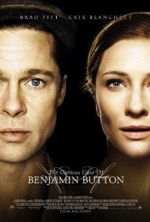
Starring: Brad Pitt
December 2008
“Masterly Telling of Fitzgerald’s Timeless Tale”
Originally, I had considered writing this review backwards, in keeping with the movie’s reverse polarity plot, but decided it would require too much effort to write and would be too demanding on the reader. So then, this linear review of director David Fincher’s The Curious Case of Benjamin Button will attempt to convey the essence of the story’s unusual plot device, which was first conceived by F. Scott Fitzgerald in his short story of the same name, published in 1922. The film certainly lives up to the curious part of its title since it chronicles events in the life of the eponymous character, an altogether average man save for the fact that he ages in reverse.
The story is set in New Orleans in 1918. Born as a tiny, wrinkly old man, Benjamin is raised by a black nursing home worker, Queenie Weathers (Taraji P. Henson). During the early years of his life, Benjamin’s weak legs require him to walk around with the assistance of crutches, but he’s miraculously healed of his infirmity at an evangelical tent meeting. At age twelve, the course of Benjamin’s life is forever altered when he first meets redheaded Daisy. And so his life goes—year after year filled with successes and failures, a war, an affair, a few heartbreaks, an occasional happiness and the loss of many friends—until Benjamin dies as a baby at age eighty-four.
After accepting the narrative conceit and identifying with the plight of the characters, Curious is a profoundly moving examination of what it means to be human and the brevity of our existence. Achieving that level of appreciation might be a chore for many viewers due to the film’s unusual mode of story conveyance, a large number of uneventful dramatic sequences and a running time of two hours and forty-six minutes. As such, the film may end up being immensely enjoyable for some or tortuously interminable for others.
As for me, I’m a proponent of the former, largely because of the intriguing story line, Fincher’s superlative direction and deeply affecting performances by Brad Pitt, Cate Blanchett and Tilda Swinton. Despite the film’s length, I never once looked at my watch or started squirming in my seat…a testament to the enduring salience of Fitzgerald’s source material and Fincher’s incisive vision in translating it to the big screen. A lot of hoopla about the director’s creative prowess, to be sure, but this is a film that could’ve derailed at multiple junctures were it not for Fincher’s efforts in realizing this sprawling story in personal and meaningful ways.
As was teased earlier, the movie’s performances are nothing short of astounding. Pitt mesmerizes in a role that has redefined his career and left little doubt as to his potential to become, as he has here, a powerhouse dramatic actor. Pitt’s age appropriate acting, aided in no small measure by the make-up and CG effects which incrementally transform the actor into progressively younger versions of his character, is absolutely flawless.
Cate Blanchett, again, defies the boundaries of what a performer can achieve as Benjamin’s childhood friend turned romantic interest, Daisy. Daisy is the film’s most difficult role to play since she not only occupies the closest orbit around Benjamin, but also rotates in the opposite direction from him. Like ships passing in the night, Daisy must come to terms with the realization that a relationship with Benjamin is doomed to fail before it even begins. And yet, such knowledge doesn’t dissuade her from bestowing upon Benjamin the rarest form of devotion…she willingly trades a few years of joy and fulfillment for decades of thankless service as a caregiver for her continually regressing soul mate. Despite Benjamin’s status as central character, Daisy, as the impetus behind Benjamin’s every action and decision, is the film’s focal point and emotional anchor.
One of the movie’s profound ironies is how an intimate story about one man’s life can feel so epic. The film is a poignant exploration of our own mortality and a powerful reminder that our lives are defined by the sum of our choices, the totality of our experiences and the indelible mark we make on those we leave behind. If there’s a silver lining to passing on, the movie captures it fully; the warm glow of a gilded gloaming is a signature seen throughout Fincher’s extraordinary film. It’s a gentle reminder of the impending sunset that faces us all and to seize the day while we possess the capacity to do so.
Curious is life affirming, but also life assessing. The movie challenges us, both with its unusual mode of storytelling and with Benjamin’s reverse chronology, to conceptualize existence in terms foreign to our own. When Benjamin’s retrograde life cycle is juxtaposed with the forward trajectory of our own reality, different aspects of humanity are revealed that otherwise would’ve been underappreciated or overlooked. This melding of timelines allows us to see ourselves with fresh eyes, as if examining our race from an outsider’s perspective. The movie’s greatest gift is the understated, yet profound, manner in which it reveals just how precious a commodity this thing called life really is, regardless of which direction we age.
Those who can endure the film’s length and implausible science for the sake of this truly unique cinematic experience will be swept away by its rich characterizations and enthralling story of a life lived well…in reverse. The human condition, with its setbacks and triumphs, ecstasies and travails rarely has found so subtle and powerful an expression in the cinema.
Rating: 4
The Tale of Despereaux (G)

Starring: Matthew Broderick
December 2008
“Non-Pixar Animated Flick Has Lots of Heart but Little Magic”
If they had extreme sports for mice, giant-eared Despereaux would own every record. Despereaux leaps through the air and steals a piece of cheese from a mouse trap without even breaking a sweat. His friends watch in amazement. None of them would ever attempt such a circus act…not even for fresh cheese.
Despereaux fails to cower when his teacher shows him a picture of a cat. To make matters worse, he doesn’t recoil when he’s shown a picture of a needle. Filled with amazement, Despereaux reverently asks, “Is that a sword?” Despereaux’s teacher calls an emergency conference with his parents; something has to be done about the misfit mouse. Like many of us, Despereaux just isn’t quite normal.
Based on the Newbery Award-winning children’s book of the same name by Kate DiCamillo, The Tale of Despereaux, judging from its marketing campaign, seemed poised to be the family film of the holiday season. Armed with a built-in audience, one of the most adorable animated creatures to grace the big screen in years and a fairytale story brimming with adventure and romance, it’s inconceivable that such a sure-fire crowd-pleaser could be a disappointment. And yet it is.
So what went wrong with Despereaux? Was it the selection of vocal talent? Definitely not! The movie boasts an impressive array of A-list luminaries, all of whom perfectly match the character they’re voicing. If you want to make great soup you need the right ingredients and any producer would kill to have names like Matthew Broderick, Dustin Hoffman, Emma Watson, Tracey Ullman, Kevin Klein, William H. Macy, Stanley Tucci, Ciaran Hinds, Robbie Coltrane, Frank Langella, Christopher Lloyd and Sigourney Weaver stirred into their story stock.
Was it the animation? Doubtful. Although the film’s palette and aesthetic is measurably more earth-tone and moderate than most animated forays these days, Despereaux is beautifully drawn; one of the movie’s greatest advantages is that it doesn’t try to emulate Pixar’s plush look. My only gripes with the animation are that the humans look like they’ve had their heads pinched in a vise and that the underground scenes are far too drab, especially for the impressionable kiddies in the audience.
Was it the story? Most likely. Will McRobb’s adaptation of DiCamillo’s story, though ambitious, resembles a ball of yarn that’s been pawed at and kicked around the room all day; you can discern the story’s overall core, but many plot strings lay strewn over the surface of the patchwork plot. The first major problem with the story is its perpetual POV shift between Despereaux (Broderick), rat-looking mouse Roscuro (Hoffman), Princess Pea (Watson) and the plump maid, Miggery Sow (Ullman). As the story bounces back and forth, it’s easy to loose the through line and difficult to discern an overarching theme or moral. Even though all of the plot threads eventually join to form a taut braid by the end, the main story—the tale of Dexperaux—is often subordinated by the movie’s riveting (Roscuro’s desperate attempts to break away from a hoard of nefarious rats), terrifying (the princess is kidnapped by the same rodent throng) and heartwarming (Miggery and her long-lost father are reunited) subplots.
The biggest narrative failing is the persistent, heavy-handed narration that not only spells out everything in the story, but also tells us how we should feel about it. Sigourney Weaver’s melodious intonations fit well with the movie’s storybook mood, but the narrated segments impede the flow of the story; serving, in essence, as filmic speed bumps. The movie’s slow pacing is directly attributable to its excessive exposition, which comes from the desire to be as faithful to the source material as possible; an honorable intention yet detrimental inhibition where the plot is concerned.
In the final analysis, the movie’s mixed results simply may be due to the fact that it wasn’t made by Pixar. However unfair that statement may be, The Tale of Despereaux is still an above average animated tale; and at the end of the day, most kids won’t discriminate too much over which studio produced it. The movie deals with many themes such as standing up to evil, breaking the chains of hurt and extending forgiveness to others, but it doesn’t possess that one crystal-clear concept that drives home a movie’s message. Such streamlined storytelling catapulted each of the Pixar films into the A tier of animated films. Despereaux will have to settle for B tier status, but there are much worse fates…it might not be WALL-E, but at least it isn’t Fly Me to the Moon.
Rating: 2 1/2
The Boy in the Striped Pajamas (PG-13)

Starring: Asa Butterfield
November 2008
“Chilling, Childs-eye View of the Holocaust”
Many who see The Boy in the Striped Pajamas will describe it as Schindler’s List through the eyes of a child. Though essentially accurate, the statement is oversimplified and quickly unravels when minor comparisons between the two films give way to vast differences in perspective, style, narrative, scale and tone. Schindler’s List told the true tale of a German altruist who saved hundreds of Jews from the horrors of concentration camps. By contrast, The Boy in the Striped Pajamas is a fictional story that focuses on a German lad’s forbidden friendship with a Jewish boy of the same age; the two are separated by status, race and an intervening electric fence. The epic is exchanged for the intimate in this short and somber holocaust film, written and directed by Mark Herman. Taking into account the above variations in form, The Boy in the Striped Pajamas has left its own indelible mark on the most dire and dismal subcategory of World War II films.
The movie opens with a German family moving from Berlin to a mansion in the countryside. The father, Ralph (David Thewlis in a masterful turn as a duty-bound German soldier), has been reassigned as the commandant of the nearby concentration camp. Ralph’s son, Bruno (Asa Butterfield), resents having left his friends behind and is perpetually bored, spending much of his time in a tire swing. One day, Bruno’s innate curiosity and insatiable desire to explore the natural world gets the better of him and he blazes a trail into the neighboring wood; Bruno eventually happens upon a barbwire fence, behind which sits a young boy clothed in what Bruno perceives as striped pajamas. Bruno introduces himself and discovers that the young boy’s name is Shmuel (Jack Scanlon). Shmuel’s striped shirt has a patch with numbers on it, which Bruno mistakenly thinks is used in some kind of game. Bruno inundates Shmuel with questions about the camp, the strange looking “farmers” that work there, and why it smells so bad when smoke is billowing out of two nearby chimneys. Upon learning that Shmuel is trapped inside the fence, Bruno incredulously asks, “Are you not allowed out? Why? What have you done?” Shmuel simply replies, “I’m a Jew.”
Bruno’s confusion regarding his newfound Jewish friend intensifies when Bruno’s tutor tells him, “If you ever found a nice Jew, you’d be the best explorer in the world.” Befriending Shmuel becomes even harder to justify when Bruno’s sister, Gretel (Amber Beattie), refers to Jews as “evil, dangerous vermin.” Turning to his father for answers to his burning questions, Bruno is told that Jews aren’t even human.
It’s hard to imagine that such racial epithets and derogatory remarks could be made by members of a civilized society, especially by a race of people so preoccupied with proving their own superiority. As difficult as it is for adults to fathom the atrocities committed by Nazis, the holocaust makes even less sense to children. Bruno simply can’t comprehend why his friend is made to endure harsh conditions or abusive treatment from Nazi soldiers. The movie’s climax is a heartrending chain of events that culminates in a shocking conclusion guaranteed to leave you, and the rest of the audience, in stunned silence.
Based on the novel by John Boyne, Herman’s script somehow manages to conjure up complex emotions from within its simple structure. Herman doesn’t overstate his case, but allows his superb cast to carry the story forward in organic, realistic ways: Thewlis and Vera Farmiga, who plays Bruno’s mother, are perfectly matched as a couple polarized by the unthinkably inhuman deeds being undertaken at the camp. Farminga delivers one of the finest crying scenes ever committed to film, and the look on Thewlis’ face at movie’s end says far more than an elaborate monologue ever could.
Though told on a much smaller canvas than most holocaust films, The Boy in the Striped Pajamas is just as effective. As the screen gradually fades to black, in one of the slowest dissolves in motion picture history, the horrific tableau of a gas chamber forms ghost images in our eyes; a haunting reminder of the unconscionable activities that took place in Nazi concentration camps. There’s no reconciliation here; just grim reality. The only happy ending that can be derived from the film is a personal determination to never again allow such heinous crimes to be visited upon any race of people. Due to a few graphic scenes, the film isn’t recommended for children, but is strongly encouraged for teens and adults as a sobering reminder of this dark chapter in human history.
Rating: 3
Twilight (PG-13)

Starring: Kristen Stewart
November 2008
“Teenage Romance Takes a Walk on the Dark Side”
In 2001, the WB network took a chance on a different kind of superhero show; their motto was “no tights and no flights.” The series takes place in Smallville (the show’s title in case you haven’t guessed it), Kansas, and focuses on superhuman happenings amid everyday, rural life; the town definitely lives up to its name. The show features a handful of flawed yet interesting adults, who take a backseat to the well-adjusted, multiracial students at the local high school. Each of the teens has a defining hobby, i.e., newspaper editor, athlete, coffee shop proprietor, and a few even display special abilities, especially an angst-ridden teen named Clark Kent.
Though a point-by-point comparison breaks down in places, Twilight, based on the teen novel of the same name by Stephenie Meyer, is similar enough to Smallville to validate the reference. The movie opens with unsettled teen, Bella Swan (Kristen Stewart) embarking on a cross-country journey from her mom’s place in Phoenix, AZ to her dad’s house in Forks, WA…purportedly the wettest place in the continental US. Forks is overcast, brooding and moody, much like Twilight’s melancholic heroine. As Bella adjusts to her new high school, she meets Edward Cullen (Robert Pattinson), a pale-skinned heartthrob who looks even more despondent than Bella. Edward and his mysterious, mishmash family are misunderstood by the town’s populace, many of whom believe the Cullen’s are part of a cult. Of course, as the story would have it, Edward and Bella fall hopelessly in love and they live happily ever after. Well, not quite.
There are several ingredients that make this story irresistible. Starting with the source material, Meyer’s world is fully formed, which makes it easy for us to be drawn into the reality of the movie. Twilight embodies many universal themes, such as: overcoming prejudice, the struggle to fit in and not overdoing the glitter. Well, maybe not the last one, but the scene I’m referring to will go down as the film’s biggest blunder.
The movie’s setting is simply magical. I’ve been to Forks, and I can tell you it looks just like it does in the movie. In fact, the location work so completely captures the feel of the damp, musty, puddle-pocked burg that my allergies flared up just looking at it.
The movie’s money scene takes place right after Edward gives Bella a piggyback ride to the top of a towering pine tree. In a beautifully filmed sequence, the camera swoops down and circles around the teenage lovebirds (it’s reported that the elements were so severe the actors were nearly blown off the boughs). Director Catherine Hardwicke then cuts to a panoramic view of a mist-draped valley where a writhing river snakes its way down the valley toward the mountains on the distant horizon. Anyone who’s been to the Pacific northwest will be flooded with memories at seeing this gloomy, yet awe-inspiring vista.
Hardwicke and her casting director have assembled an exceptionally talented and attractive group of young actors, many of whom will undoubtedly go on to become major Hollywood stars. I don’t think anyone would argue that Pattinson and Stewart have enough chemistry to stock a science lab, but Twilight is much more than a two pony show. In fact, Twilight’s cast may qualify as the finest ensemble of no-namers I’ve ever seen in a film. Standout performances are turned in my Billy Burke as Bella’s dad, Charlie, Peter Facinelli as Dr. Carlisle Cullen, the patriarch of his clan, Taylor Lautner as Jacob, Bella’s Native American friend and Cam Gigandet as James, Bella’s stalker.
If you’re familiar with Twilight’s premise, you’ve surely noticed by now that I’ve taken extra care not to reveal even the most basic secrets of the film. I’ve shown such restraint so that people who haven’t read the books (like me), can enjoy the film on its own terms without having everything spoiled before they enter the theater. Though most people will have prior knowledge of Edward’s secret, my aim is to preserve the mystery for the three people in Zambia who’ve never heard of Twilight.
Whereas Harry Potter has captivated kids and pre-teens, Meyer’s novels have captured the hearts and minds of teens everywhere and even a few fantasy-prone adults like me (my favorite scene is the “baseball” game). Twilight is an engrossing world, made memorable by its exciting set of fresh conventions and original characters. I would think that any degree of box office success would guarantee a series of films. Up next: New Moon.
Rating: 3
The Express (PG)

Starring: Rob Brown
October 2008
“Inspiring, if Derivative, True Story Adaptation”
We’ve seen this kind of film many, many times before. As a story centered on an individual athlete, it pales in comparison to Rudy. With respect to its tragic resolution, it resembles Brian’s Song, although it’s not nearly as emotionally overwrought as the James Caan, and Billy Dee Williams’ gridiron classic.
The movie in question is The Express: The Ernie Davis Story. Recruited by legendary Coach Ben Schwartzwalder (Dennis Quaid) to play running back for the Syracuse Orangemen, Davis (Ron Brown) follows in the footsteps of such greats as Jim Brown. We’re afforded glimpses into Davis’ childhood, how pursuing bullies forced him to become a fast runner, as well as an overview of his college years with actual footage of Davis’ real games. His college career culminated with a landmark event in collegiate sports…Davis became the first African American to win the Heisman Trophy.
Brown (Coach Carter) is adequate as Davis but is somewhat laconic, which beautifully fits the part since Davis was the kind of athlete who did his talking on the field. Quaid is much more gruff here than in his past sports movies; his gravelly, smoker’s voice is used with great effect for the no-nonsense coach. Of the supporting cast, two standout performances are turned in by popular character actors Clancy Brown, who plays the assistant coach, and Saul Rubinek, who portrays the owner of the Cleveland Browns, Art Modell.
Though primarily focused on Davis, the story touches upon racism, which was certainly a major social challenge of the period in question. In one scene, rowdy fans toss glass bottles down at the players (even the white ones) because the team had a prominent black athlete as a starter. Even though we’ve seen racism portrayed in other sports flicks, such as Remember the Titans and Glory Road, the movie would’ve been remiss had it not at least touched upon this hot-button, contextualizing, topic.
There’s an inspiring thread of tradition that runs through the film. Coach Schwartzwalder coaxes Jim Brown into recruiting Davis and near the end of the film, Davis, again at the urging of his former coach, helps persuade Floyd Little to play for the Orangemen. The color orange was present during Little’s entire football career: after college, Little went on to play for the Denver Broncos, becoming the nascent franchise’s first star running back. Inspiring, if not amazing, The Express pays fitting tribute to the brilliant career of a class athlete and all-around decent human being who left us far too soon.
Rating: 3
Lakeview Terrace (PG-13)

Starring: Samuel L. Jackson
September 2008
“I’ve Got My Eye on You!”
Have we really come all that far? Are we, as a society, just as racially motivated as we were during the Rodney King riots or even the Jim Crow era? Those are the challenging, haunting questions posed in Neil LaBute’s tight, taut and terrifying thriller, Lakeview Terrace.
The movie stars Samuel L. Jackson as Abel Turner, a hot-tempered cop, who’s coping with his wife’s recent death in a tragic car accident. Abel disapproves of the interracial couple that recently moved into his diverse, titular neighborhood—Caucasian Chris (Patrick Wilson) and African American Lisa (Kerry Washington)—and determines to make their life a living hell in an effort to force them out of the community. But are such extreme acts as home invasion and slashed tires committed by morally superior Abel or by some other unseen agency?
In his most ambitious and multifaceted role to date, Jackson turns in an Oscar-worthy performance as a disturbed soul who walks the tightrope of legal and illegal activities, all the while shielded by the badge he wears. Abel often goes to extremes when teaching others a lesson. Instead of talking down a drug dealer who has a shotgun to his chin, Abel encourages the man to pull the trigger. When the hood chickens out, Abel cuffs the man, satisfied that the dealer will never again contemplate suicide.
In another jaw-dropping scene that you’ll be trying to get out of your head for days, Abel drops his britches in front of Lisa to illustrate how there are no longer any standards in our country. When Lisa threatens to call the police, Abel hands her his cell phone and says, “You want to call the cops? Here, I’ll tell you who’s on duty.” After the episode, Lisa throws up in the sink. Knowing that she can’t tell Chris, for fear of his reaction, Lisa knows she’s trapped. And therein dwells the primary dilemma at the core of this spine-tingling thriller: Who do you call when you can’t call the cops?
As the object of our identification, Chris is the most pivotal character in the film. We can feel his frustration when Abel’s outside floodlights keep him up at night. We can sense his barely contained anger when Abel embarrasses him in front of his wife and their guests at a housewarming party. Even though Abel makes for a fascinating character study, he would have come off as too cartoonish or maniacal were it not for Chris’ “can’t we all just get along” persona as a counterbalance. If Wilson’s acting had been only half as convincing, the movie would have fallen flat…his subtle performance is the key to making the film a viable reflection of reality.
Juxtaposed with the thriller narrative is the issue of racism, or in this case, reverse racism. The film takes a hard look at interracial marriage and the ramifications of such a union—the potential for a mongrel child. Writers David Loughery and Howard Korder tackle these issues in an unflinchingly intelligent manner without sermonizing or choosing sides. What’s even more frightening than the movie’s racial epithets is Abel’s acerbic statement, “Why don’t you go back to where they accept your kind of people.” Lakeview Terrace is in an L.A. suburb. L.A. is one of the largest melting pots in the world. If not in L.A., where would Chris and Lisa find acceptance as an interracial couple?
Though the pacing is slow in spots, LaBute (The Wicker Man) has crafted a visually engrossing film. His use of close-ups reveals the deep-seated motivations of his characters; his clever framing techniques are also superb. In fact, there’s just as much subtext being conveyed through cinematography as there is through dialog, facials and body language, which makes the viewing experience a real treat.
Throughout the movie, a fire rages in the surrounding mountains and edges ever closer to the neighborhood; as the action intensifies so does the inferno, which becomes a symbol for the film’s violence and racial tensions. In spite of its recurring racial slurs and graphic language, the film possesses many redeeming qualities, not the least of which is an intelligent, nuanced and textured story. Lakeview Terrace is an uncommonly good thriller that engages the senses with pulse-pounding showdowns and cliffhangers. As a didactic and climactic thrill ride that gradually builds suspense layer upon layer, the movie’s structure, ironically or intentionally, resembles a terrace.
Rating: 3
Star Wars: The Clone Wars (PG)
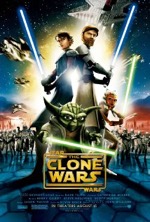
Starring: Matt Lanter
August 2008
“First Wars Animated Feature Ironically Feels Like a Clone”
In the final frontier, the good ship Enterprise is ever ready to respond to one intergalactic crisis or another and, conveniently, always seems to be the closest ship to a cosmic conflagration. Panning over to the galaxy far, far away, of all the Jedi Knights in the Old Republic—and there were myriad during the Clone War epoch—Obi-wan Kenobi and Anakin Skywalker always seem to be right in the middle of some uprising involving the Separatists and their droid armies, or engaging Count Dooku and his assassin apprentice Asajj Ventress in lightsaber duels, or avoiding the traps set by evil mastermind Chancellor Palpatine/Lord Sidious. Indeed, at the outset of the first full-length animated feature in the Star Wars stable, simply titled The Clone Wars, diminutive, inverted-speaking Jedi Master Yoda affirms that among the teeming ranks of Jedi Knights only two Jedi are available to rescue Jabba the Hutt’s kidnapped son…you guessed it, Obi-wan and Anakin.
To say that the film’s intro represents a catastrophic tremor in the Force for Wars fans is a galactic understatement. There’s no Fox fanfare (the movie is being distributed by Warner Bros.), no opening crawl of expository back-story and in place of the familiar, rousing score we’re served a bastardized version of John Williams’ legendary Main Title that goes down like flat 7up. From the outset, this new film feels like a cheaply made knockoff of creator George Lucas’ space saga rather than an official chapter.
The movie opens with a futuristic news reel which focuses on the aftermath of Star Wars: Episode I and II (in case spectators missed the prequels and stumbled into the theater by accident). The first half hour is one continuous battle; essentially a cut and paste job of various action sequences from Episode II and the brilliant animated shorts by director Genndy Tartakovsky, as shown on the Cartoon Network between 2003 and 2005—an animated series based on this film, which serves as a pilot of sorts, will air on the same network this fall.
During a break in the action, reinforcements arrive and we’re introduced to Anakin’s new Padawan, Ahsoka Tano (Ashley Eckstein); a plucky motor-mouth who’s a thorn in her master’s side just like Anakin was with Obi-wan. Ahsoka, who’s amusing for about fifteen minutes, becomes an obnoxious know-it-all by movie’s end. Still, the red-skinned youth is the only fresh element in the movie and her incessant bantering with Anakin is the movie’s only saving grace.
After the video game opening plays out, the second half of the film stumbles into something that resembles a story. Several of the subplots had the potential to develop into something substantive, namely the rescue of Jabba’s son, Kenobi’s lightsaber duel with Ventress, Anakin’s lightsaber confrontation with Dooku, Dooku’s plot to implicate the Jedi in the kidnapping of Jabba’s son and Amidala’s failed negotiations with Jabba’s uncle, Ziro the Hutt. Unfortunately, it’s all wasted effort because none of these narrative threads are given a chance to develop independently from melees, explosions and every other action element that fills twelve-year old boys with awe and excitement.
The main problem here isn’t the insipid plot, stiff animation, beaten-to-death conventions, or playground dialog. It isn’t even the fact that the only original actors to lend their voices are Samuel L. Jackson as Mace Windu, Christopher Lee as Dooku and Anthony Daniels as C-3PO. The biggest drawback to The Clone Wars is that it’s little more than a publicity stunt. As the lead-in to the upcoming animated series, the movie feels like a glorified cartoon; and since each of the main subplots resolve right around the thirty minute mark, the movie can be cut into three episodes and rebroadcasted on TV with little effort. What sours the blue milk here is the knowledge that Lucas green-lit the project solely to promote the new series. Does Lucas even care if the movie makes a profit? It seems like he just wants exposure for the series, which is yet another sneaky way of marketing his brainchild…something he mastered long, long ago.
The Clone Wars, however visually stimulating, is a dreadfully remedial tale that maneuvers the saga dangerously close to self parody. With two mediocre efforts turned in this summer (Indy IV), Lucas’ name on the street is about as good as M. Night Shyamalan’s. If Lucas isn’t careful, he’s going to alienate the remnant of die-hard fans; and when that happens, his fire will have gone out of the universe. All of a sudden, The Star Wars Holiday Special (1978) and the two Ewok TV movies don’t look so bad.
Rating: 2
Mamma Mia! (PG-13)
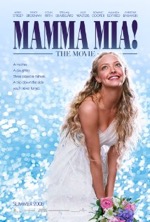
Starring: Meryl Streep
July 2008
“Thank You for the Music, But What About the Story?”
Having never seen the theatrical version of Mama Mia! I didn’t know what to expect from the new film version, other than I was going to see a musical. And a musical it is; songs permeate and dominate all but about fifteen minutes of the film, so if you’re not a person who enjoys musical movies this definitely isn’t for you. As an unrepentant Chick Flick and an uninhibited musical, the film is clearly marketed toward the female set, so most men (those dragged kicking and screaming into the theater by their female companions) will have a hard time swallowing or following the movie’s song-a-minute storyline.
The movie’s slogan is: “A Mother. A Daughter. Three Possible Fathers.” Believe it or not, that’s about all there is to the plot. The vast majority of the story is told via nineteen songs from ABBA’s catalog—some bouncy, some groovy—which are sung by the stars along with a host of extras performing over-the-top choreography and wearing Juicy Fruit smiles. Of course, after about the fourth or fifth musical number all of the songs start sounding like a broken record…er 8-track, and while I applaud the film’s use of the actors’ actual singing voices, some of the solo work is flower-wilting bad. Besides the movie’s overabundance of musical numbers, the biggest disappointment is the utter absence of character moments. However, the acting, directing, music, choreography and technical elements make up for any lack in the story department, and the on location filming on an idyllic Grecian island is a significant factor in the film’s overall mood and aesthetic.
The movie’s casting was spot-on and veterans Meryl Streep, Pierce Brosnan, Colin Firth, Stellan Skarsgard and Christine Baranski, along with newcomer Amanda Seyfried, deliver delightful performances. Streep is her usual stellar self as mamma-with-a-past Donna, but it’s Seyfried as Donna’s debutante daughter, Sophie, who steals the show with her zest for life and inextinguishable desire to discover her dad. In a strange case of role reversal, Sophie provides maturity, responsibility and just good common sense to balance out her flighty, wild and emotionally needy mother. Though the movie stays on the periphery of meaningful issues like empty-nest syndrome, regret over lost love and paternal responsibility, it wastes much of its efforts on bawdy jokes and obscene gestures; most of them perpetrated by Donna and her lusty gal-pals.
Mamma Mia! is a light, breezy jukebox musical that fulfills its promise to be a two hour dance party and is the feel-good movie of the summer. It’s a story about young love and rekindled love; in fact, it’s all about love. How fitting that, despite its vacant narrative, Mamma Mia! is a movie you can’t help but love.
Rating: 2 1/2
The Dark Knight (PG-13)
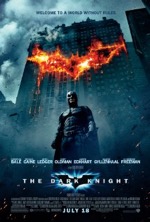
Starring: Christian Bale
July 2008
“Dark and Disturbing Bat-sequel Doesn’t Clown Around”
So how do you follow up a box office smash that not only rebooted a franchise but also proved beyond doubt that a comic book film could achieve high art status? Take a cue from Star Wars! George Lucas’ second Star Wars movie, The Empire Strikes Back (1980), was, in its day, the most successful sequel of all time. Empire kept audiences coming back with its bold new direction, darker tone and bitter outcomes, i.e., the bad guys occasionally win and the good guys get frozen and loose appendages.
The Dark Knight, like Empire, resisted the urge to rest on the success of its predecessor (Batman Begins) by taking a sharp left turn into the seedier and grittier regions of Gotham’s crime-infested underworld. Living up to the darkness denoted in its title, The Dark Knight is a well-crafted heist film, a highly styled noir and an elaborate Greek tragedy all wrapped up into a tangled, yet cohesive, ball of narrative yarn. Call it Batman meets The Departed.
Deuces are wild in The Dark Knight: besides being the second film in the series, it features two villains (one is even named Two-Face). The score was arranged and conducted by two veteran composers, Hans Zimmer and James Newton Howard: not since Jaws has an ascending two note main theme been used with such terrifying effectiveness. There’s also enough plot for two movies here and, as such, some may consider The Dark Knight to be too long.
With a movie as finely mounted and expertly executed as The Dark Knight, it’s nearly impossible to find fault with the film, and an objection leveled at any part of the picture is tantamount to a baseless attack; like pointing out one errant brushstroke in the Mona Lisa. Just the same, here are my gripes: Though the action is frenetic out of the starting gate, Nolan and David S. Goyer’s story is slow to unravel—the main point of the movie doesn’t coalesce until somewhere near the middle. Another minor irritant is the choose-your-own-fate gimmick which was used ad nauseam in the Spider-Man movies. Here, The Joker (Heath Ledger), who claims to be a man without a plan, sets up two separate scenarios where one person/group must be sacrificed so that the other person/group can live. Once is acceptable, twice is overkill in the same movie. Nolan’s one directorial miscue is his overuse of 360 degree tracking shots which keep spinning around until we’re all sufficiently dizzy. Oh, and is it my imagination or has Batman developed a speech impediment since the last movie?
On the flip side of the coin, the movie’s directing, acting and production values are nearly unimpeachable. The sweeping overhead cityscape shots are breathtaking as are the pulse-pounding action sequences. Nolan expertly, almost imperceptibly, alternates his action scenes between day and night. He also cleverly juxtaposes Harvey Dent, Gotham’s White Knight, with Batman, the city’s Dark Knight, and effectively turns the old “good guys wear white, bad guys wear black” Western film convention on its ear.
Most of the supporting ensemble was retained from the first film, including Michael Caine as Alfred, Gary Oldman as Lt. Gordon and Morgan Freeman as Lucius Fox; all of whom have meaty subplots here. Journeyman character actor, Eric Roberts, represents a crucial piece in the crime puzzle as mob boss, Salvatore Maroni, and Anthony Michael Hall keeps us well-informed as an earnest news reporter. The only significant casting change is that of Rachel Dawes: Maggie Gyllenhaal has replaced Katie Holmes, who received career-stalling advice from hubby Tom Cruise when he steered her toward a part in Mad Money and away from reprising her role in the Bat-sequel. Gyllenhaal immediately hits her stride as conflicted lover Dawes; Bruce’s old flame and Harvey’s new squeeze. If anything, Gyllenhaal’s portrayal of the driven young attorney is less strident and more balanced than Holmes’ Dawes, but, even with a successful baton exchange, it’s a shame that character continuity had to be disrupted.
Much has been made of Ledger’s maniacal riff on The Joker and his shocking death a few months after wrapping this film. Clamoring fans have petitioned for a posthumous nod for the Australian actor—solely based on what they saw in the trailer, mind you—but such wish fulfillment may prove too optimistic come Oscar season despite Ledger’s career-defining performance. Ledger’s Joker is, inexplicably, less sinister and psychotic than Jack Nicholson’s version of the Clown Prince of Crime in 1989s Batman. Still, this Joker is more accessible and less predictable which is far more entertaining to watch, especially when the mad genius outsmarts the cops and Batz at practically every turn. Whether or not Ledger gets a nod, this will go down as his most iconic role and Hollywood’s most effective villain since Hannibal Lecter.
As strange as it sounds, the focal point of the film isn’t Batman or The Joker, but Harvey “Two-Face” Dent (Aaron Eckhart, who delivers a superbly multi-faceted performance). Dent’s tragic fall from grace is the emotional and thematic vertex of the film. As an unwitting pawn, trapped between powerful agents of good and evil, Dent is forced to choose sides. His brazen statement, “You either die a hero or you live long enough to see yourself become the villain,” is a self-fulfilling prophecy; for in the end, The Joker outmaneuvers Batman and turns the crusading district attorney to the proverbial “dark side.” You can bet we’ll be seeing more of Two-Face in the next movie.
On the technology front, the highly advertised new Batpod is only in the movie for a few minutes before being totaled. Some may feel short-changed, but I find it refreshing, even ironic, that in a big budget action/adventure film the main attraction isn’t the FX or the newest hi-tech gizmo or machine, but rather, the hero’s courageous sacrifice, the villain’s psychotic schemes or the plot’s many twists and turns. Perhaps Batman films are helping to redefine the summer blockbuster as something other than a progression of filler scenes in between CG battles. One can only hope.
Though this wasn’t the sequel I expected, it’s hard to argue with the results. The movie’s direction is masterful, the writing is inspired, the acting is pitch-perfect and the production elements are superior in every category. This is an epic crime saga that just happens to have Batman in it…and that’s just the way Nolan wanted it.
Why so serious? Because The Dark Knight is a seriously good film that will captivate and exhilarate fanboys and casual viewers alike. Let’s just hope that Oscar takes it seriously!
Rating: 3 1/2
WALL-E (G)
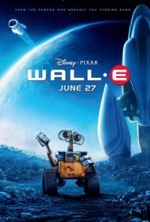
Starring: Ben Burtt
June 2008
“Animated Triumph Takes Us to Infinity and Beyond”
The latest feature film from Disney/Pixar may be an animated movie, but it certainly isn’t a kid’s movie. That’s not to say that kids won’t enjoy it or that it’s inappropriate for children, because that certainly isn’t the case. What I mean is that Pixar has delivered its most adult film to date; a hauntingly beautiful, elegantly whimsical and poignantly instructional CGI tour de force.
WALL-E tells the story of the last “living thing” on earth (other than cockroaches, of course) after humans abandoned their trashed and thrashed home world in search of greener pastures in the heavens. WALL-E (Waste Allocation Load Lifter-Earth), the eternally curious, binocular-eyed robot, has been assigned the unenviable task of cleaning up the desolated surface of our planet all by himself. WALL-E’s existence is fairly routine—gathering trash, compacting refuse into waste cubes and constructing veritable mountains out of the cubes—until a mysterious ship literally lands on top of him. The alien vessel dispatches a probe and quickly shoots back into space.
WALL-E is immediately stricken by the alabaster, egg-shaped probe, whom he soon learns is named EVE (WALL-E pronounces her name “Eva”). EVE barely acknowledges WALL-E’s existence until, in a desperate act to impress the mission-minded probe, WALL-E presents EVE with a gift—the solitary shoot of a plant potted inside an old boot. EVE snatches the plant, stores it inside one of her compartments and immediately shuts down. Try as he might, WALL-E fails to snap EVE out of her self-imposed trance; EVE is completely lifeless, save for a green flower symbol flashing on her sleek surface. Once again, WALL-E is relegated to a life of loneliness.
From that brief synopsis of the movie’s opening act, many would perceive WALL-E to be a dark, dismal, despondent, dystopian yarn, but nothing could be farther from the truth. I know this is quite a boast, but WALL-E has more heart than any previous Pixar picture, which is ironic since it prominently features emotionless, whirring robots as its main characters. Some humans appear in the story, but they certainly don’t resemble our race at present, although the story is clearly warning us against becoming the shallow, convenience and consumer-driven society portrayed in the film. WALL-E, set 700 years in the future, is clearly a cautionary tale, but instead of simply leaving humans to wallow in the slough of our own making, the film illustrates the indomitable spirit of our race; the film powerfully illustrates humanity’s ability to adapt and aspire. Of the few lines of dialog in the film, the best one comes from the captain of the space cruise liner, Axiom. Once his eyes are opened to how life was on Earth, pre-apocalypse, the captain exclaims, “I don’t want to survive, I want to live!”
At the heart of the film is the improbable, unconventional, yet deeply moving romance between WALL-E and EVE. Built upon sacrifice and simple acts of kindness, their artificial relationship is more emotionally resonant than the majority of human love affairs that populate modern cinema. I never thought I’d tear up at an animated film, especially one centered on two lovebird robots, but at times I couldn’t help it. So great is Pixar’s mastery of narrative, and anthropomorphized characters, that it can seemingly control a spectator’s emotions at whim. Pixar artisans are truly digital alchemists.
It almost goes without saying that the movie’s animation is stellar, but Pixar has taken CGI to new heights in WALL-E, especially during the beautifully choreographed fire extinguisher in space sequence. Pseudo-documentary quick zooms infuse the prologue with some energy and the Chaplin-esque physical humor, along with Ben Burtt’s inspired vocalizations, makes for some captivating and amusing vignettes, like when a confused WALL-E places a spork in-between his spoon and fork collections.
From the movie’s lyrical opening to its unconventional resolution, WALL-E is an instant masterpiece and a triumph in feature length animation. What started out as the most dubious Pixar film, judging from the film’s insular trailer, has turned out to be the studio’s most ambitious effort with the biggest payoff; the film is, hands down, the most profound animated movie ever made and very nearly qualifies as the Citizen Kane of its form. Though unabashedly bleak in spots, WALL-E is an affirmation and celebration of life in any form, even the most inconsequential. Hand over the Oscar for Best Animated Movie. WALL-E is out of this world!
Rating: 3 1/2
Get Smart (PG-13)

Starring: Steve Carell
June 2008
“Slapstick Comedy Missed It by That Much”
Based on the 60’s TV series, which portrayed the Cold War in a humorous light, Get Smart stars Steve Carell (who else?) as Agent 86, aka Maxwell Smart. Though not nearly as inept as The Pink Panther’s Jacques Clouseau, Smart is still a far cry from James Bond—his last name remains a bit of an oxymoron.
Agent 13 (Bill Murray) is a lonely, middle-aged man who stands watch inside a hollowed-out tree all day. Agent 23, a cocky ladies man, is played to the hilt by Dwayne “The Rock” Johnson. Agent 99 (a glacial Anne Hathaway) figures into the movie more prominently than the lower numbered agents as the no-nonsense, by-the-book veteran assigned to work side-by-side with the newly commissioned Agent 86. (Agent 99 has seniority over Agent 86, so apparently the numbering is arbitrary.)
The delightfully witty repartee between Agents 86 and 99 is one of the film’s most enjoyable aspects. Despite Agent 99’s stolid fussiness, she and Max are strangely compatible, something he readily admits and she flatly denies. The friction is palpable, and as we all know, friction causes heat.
Excellent supporting performances are turned in by several screen veterans, including: Terence Stamp, who plays the coldblooded Russian heavy, Alan Arkin, as the leader of the good guy spies and James Caan, who plays the US President.
Earlier I referenced the disparity between Clouseau and Bond and that Smart lands somewhere in between the two European spies on the competency scale. My greatest struggle with the film is that Smart lives up to his name is some areas and proves his overwhelming stupidity in others. My advice: either be competent (Bond) or incompetent (Clouseau), but not hit-or-miss. Otherwise, it’s just downright annoying.
Maxwell Smart was undeniably the right (anti-)hero for the Cold War period, but we’re in a new millennium. Iron Man has proven to be the right hero for our terror-ridden times. Placing these heroes side by side makes Smart seem embarrassingly passé.
Get Smart is exactly what you’d expect it to be, and I guess that’s what’s most infuriating about the film. Had the movie attempted to modernize Smart and company, the results might have been more cutting edge. Instead, it’s just a silly retread of the silly TV show. Like so many other recent TV-to-theater flicks, Get Smart is hedging on brand recognition and nostalgia to sell tickets. Playing it safe seldom produces innovation, so I guess we’ll settle for medium-well box office and a mediocre storyline.
Even still, Get Smart is one of the better TV-to-big screen adaptations to come along in recent years, which really isn’t saying much. It would be wonderful if the inevitable sequel would take its own advice…Get Smarter!
Rating: 2 1/2
The Incredible Hulk (PG-13)

Starring: Edward Norton
June 2008
“A Giant Green Leap Past Lee’s Stylized Flop”
Is there a better word to describe the 2003 version of The Hulk than debacle? Director Ang Lee delivered a cerebral comic-to-movie adaptation that was so painstakingly adherent to its 2D, four-color source material it turned off a large segment of the audience with its dizzying 24-style split screen boxes, headache-inducing action sequences and an angry green giant who fluctuated in size and could leap several miles with every bound. It may have been the ultimate Valentine to the comic book and its fans, but it wasn’t great cinema—judging from its critical rejection and tepid box office.
Compared to Lee’s avant-garde wild pitch, director Louis Leterrier’s vision for the Hulk is right in the middle of the strike zone, and will appeal to fanboys as well as a mass audience. The Incredible Hulk isn’t technically a sequel to The Hulk; more like a re-envisioning. In addition to a change at the helm, the entire cast has been overhauled: Edward Norton as Bruce Banner/Hulk, Liv Tyler as Betty Ross, William Hurt as General ‘Thunderbolt’ Ross and Tim Roth at Col. Emil Blonsky/Abomination.
Norton’s performance is flawless, but the rest of the cast has a hard time fitting into their characters—ironic since, initially, Norton as a superhero seemed like the most dubious piece of casting. Hurt is serviceable but a bit stiff as Gen. Ross, a crusty old war dog who constantly demands bigger guns and more backup. Tyler is too soft-spoken in her likewise understated turn—the Lord of the Rings actress defaults to her Elvish serenity in a role that required a wider emotional range. Roth is skilled at making bad guys believable, but here the actor is powerless to forge swaggering hothead, Blonsky, into a viable villain. The entire cast is victimized by shallow character development from writer Zak Penn. Assuming that his audience is already aware of the Hulk’s back-story, the ironically named Penn does little to expand the boundaries of the characters beyond what’s been established in the comic book. In essence, the characters kowtow to the rhythm and demands of the script. The word contrived comes to mind.
And speaking of contrived, the climactic battle between The Hulk and The Abomination—which comes complete with a Godzilla-style rampage through the streets of NYC—is a conventional resolution that caps a twenty-six minute slugfest between the mutant titans. The sequence is a surfeit of eye candy which, appropriately, comes crashing down after the sugar high of car tramplings, helicopter hurlings and Hulk smashings wears off. Strangulation as a means of vanquishing a foe is extremely banal and renders the eagerly anticipated climax that much more disappointing.
There are many other disappointing elements in the film, like Bruce’s perpetual inability to give Gen. Ross’ men the slip. The early stages of the film establish Bruce as an expert at lying low, so why can’t he simply disappear again? And then there’s the flaccid love triangle between Bruce, Betty and one of Betty’s colleagues (he’s in the movie for maybe five minutes and I don’t remember his name). As soon as Bruce resurfaces, Betty (apparently) dumps her boyfriend and returns to Bruce’s side as if nothing had happened during his absence. The whole sordid mess is quickly and conveniently set aside to make way for another action scene. There’s that word again…
Contrived as it is, there are some entertaining aspects to the film. Besides Norton’s finely attenuated performance, there are several amusing cameos: Stan Lee and Lou Ferrigno reprise their brief stints from Lee’s Hulk, and Robert Downey Jr. shows up as Tony Stark. Stark’s alter ego, in case you’ve been on an extended vacation off-planet, is Iron Man. Stark’s presence here marks the first cross-pollination of superheroes in a Marvel movie and also lays the groundwork for a much anticipated Avengers movie.
The Hulk is one of the finest examples of Man vs. Himself in modern mythology, and though angst hovers over the movie like a dark cloud, Leterrier, fortunately, doesn’t let it consume the film. The director pays fitting tribute to Bill Bixby, who played small screen Banner from 1977 to 1982, by revealing a brief glimpse of the actor on a TV in the background of Banner’s flat. Composer Craig Armstrong also pays homage to the TV series by employing a clever statement of “The Lonely Man” theme in his score.
Even though The Incredible Hulk underachieves, it’s still a giant leap ahead of its predecessor. Rumors persist that Norton was dissatisfied with the final cut of the film, so we’ll see if he comes back to join Barry Bonds in Hulk III: Steroid Smackdown.
Rating: 2 1/2
Indiana Jones and the Kingdom of the Crystal Skull (PG-13)

Starring: Harrison Ford
May 2008
“The Old Ford Still Drives, But the Shine is Off the Crystal”
It’s the end of the game. Three seconds remain on the clock and your team has just spent its final timeout. The kicker trots onto the field and gets into position. The ball is snapped…the kicker puts his leg into it and sends the pigskin sailing through the air. Sitting on the edge of your sofa, you wince, bite your lower lip and lean to the left to help out the ball, which continues drifting right as if being pulled off course by a giant magnet. At the last second the ball hooks, just barely clearing the right goalpost. You loudly exhale and sink back into your couch. It wasn’t pretty, but a win’s a win.
As I sat in a surprisingly half full theater on the opening night of Indiana Jones and the Kingdom of the Crystal Skull, I found myself leaning to the left on several occasions, trying to assist the long-anticipated sequel to a series I have enormous respect and reverence for and an iconic hero I’ve idolized for most of my life. But as much as I willed it to be the filmic comeback of the decade, Indy IV, though replete with engaging drama and nail-biting cliffhangers, ekes out a victory much like our cardiac kicker. There’s no doubt that Indy IV will be a hit, but what’s profoundly disappointing is how close it is to being a miss.
Indy IV comes nineteen years after the previous film, The Last Crusade, and appropriately jumps forward roughly the same span of time in fictional years. The Spielberg/Lucas/Ford vehicle takes place in 1957 during the Cold War and replaces Nazis with Russians in the antagonist department. In are two new sidekicks, Mac (Ray Winstone) and Mutt (Shia LaBeouf), but out, unfortunately, is Henry Jones, Sr. (Sean Connery, who couldn’t be lured out of retirement for one last romp as Indy’s dad). Cate Blanchett is Russian baddie Irina Spalko, a hard-nosed agent bent on discovering the mythical and metaphysical crystal skull. John Hurt plays the formerly brilliant, presently insane Professor Oxley (something about gazing into the eponymous artifact too long). Marion Ravenwood (Karen Allen), Indy’s love/hate companion in the first movie, makes a delightful return to the series—Marion shows up halfway through the film and adds relational grounding to the highflying, meandering storyline.
It gives me no pleasure to criticize an Indy movie, but I just can’t turn a blind eye toward this film’s glaring deficiencies and inconsistencies. First and foremost, the plot is an incoherently obtuse tangle of yarn laden with improbable events…like when Indy survives a nuclear detonation by hiding out inside a freezer. Another drawback is that half the movie seems to take place in one subterranean cavern or another (a la The Temple of Doom) which makes for a pretty drab viewing experience. The special effects are first-rate, but the paint-by-numbers action scenes borrow heavily from the storyboards of the earlier trilogy (it’s a bitter irony that the oft-emulated movie series now finds itself so out of gas it has to steal from itself). Also, there’s a captured/escaped/captured again plot contrivance that gets exhausting after the second or third repetition.
I could have easily overlooked these story snafus or the occasional plot hole were it not for the movie’s sci-fi subplot, which challenges the limits of believability while irreverently disregarding the established format of the other films. When the otherworldly presence is finally revealed, I had to keep from yelling, “This is Indiana Jones, not the X-Files.” The movie’s conclusion is so far-fetched and incongruous; it will leave many viewers in utter bewilderment (judging from the stunned silence during the “who-changed-the-channel?” finale and the mediocre applause at the end of the film).
Still, there are many story elements that capture the old Indy magic: The incisive interplay between Indy, Mutt and Marion is highly amusing as are the inside gags, like when we catch a glimpse of the Ark of the Covenant in a warehouse. Spielberg’s direction, barring the reheated action sequences, is patently and predictably superb. However, if the movie has a weak link, it’s Lucas and co.’s kitchen sink screenplay, which bogs down the story with too many details. Sometimes simpler is better.
As with the recent updates to the Rocky, Die Hard and Rambo series’, Indiana Jones has expanded its universe and captured the imaginations of a whole new generation. But with time working against the aging star and a less than stellar outcome here, one wonders if the series should just hang up the fedora and bullwhip. After all, the next attempt might hook too far to the left.
Rating: 3
The Chronicles of Narnia: Prince Caspian (PG)

Starring: Ben Barnes
May 2008
“Magical Sequel Takes Us Beyond the Book”
To be honest, the second book in C.S. Lewis’ The Chronicles of Narnia series, Prince Caspian, was never a favorite of mine. So the fact that the film version has an identical rating to the first movie, The Lion, the Witch and the Wardrobe, means director Andrew Adamson did a phenomenal job of preserving what worked in the book while broadening the scope and depth of the story. Having just reread the book a month before the movie’s release, I’m fairly aware of Adamson’s adaptations to the story—most additions are minor with the main change being more political intrigue among King Miraz and his traitorous lords. Unfortunately, expanding Miraz’ back story only adds to the confusion over Caspian’s role in the whole mess and still does little to elevate Miraz from misguided opportunist to malevolent villain, which is what the film really needed.
As the movie opens, Miraz’ wife delivers a son; the arrival of an heir to the throne places Miraz’ nephew, Caspian, in great danger. Fleeing the castle, Caspian stumbles upon some woodland creatures who tell him they are “original” Narnians. This comes as a surprise to Caspian, for when his people, the Telmarines, arrived in Narnia they drove out all of its native inhabitants (talking animals, dwarves, fauns, etc.), or so they thought. Caspian agrees to help the creatures reclaim their land by overthrowing his tyrannical uncle. When the battle goes ill, Caspian blows Susan’s magical horn and the four Pevensie children from the first story are magically transported back to the enchanted realm of Narnia—though it’s only been a year since their first visit, 1,300 years have passed in Narnia.
The four former kings and queens of Narnia—Peter (William Moseley), Susan (Anna Popplewell), Edmund (Skandar Keynes) and Lucy (Georgie Henley)—are joined by Caspian (Ben Barnes), Trumpkin (Peter Dinklage) and Nikabrik (Warwick Davis) in their campaign against Miraz (Sergio Castellitto). Other CG companions among the multi-species army are: Trufflehunter the badger (voiced by Ken Stott), Reepicheep the valiant mouse (Eddie Izzard), Aslan the majestic lion (Liam Neeson) and Patterwig the Squirrel (voiced by and the movie’s composer, Harry Gregson-Williams).
The battle scenes have been expanded from Lewis’ scanty skirmishes, and though they couldn’t hope to compete with LOTR’s epic sequences, Caspian’s are well-executed, especially the night raid on Miraz’ castle where griffins are used as drop ships to sneak in Caspian’s strike team. Several other nifty effects are: Narnians creating a cave-in underneath Miraz’ army, marching trees lassoing enemy soldiers with their tentacle-like roots and a river king who breaks the bridge and drowns Miraz’ troops. The trouble with all of these sequences is that they’ve already been done in LOTR. Granted, there are very few things that haven’t been done, and done better, by LOTR in the fantasy arena, but some originality would’ve been welcome.
If Medieval battles aren’t your thing, there’s plenty else to enjoy here; like lovely Lucy’s steadfast belief in Aslan, Edmund’s newfound belief in Lucy and Caspian’s fateful decision to turn his back on his own people. There’s some timely symbolism in the way the creatures and trees reclaim their land from the evil Telmarines (a lost tribe of humans). The passage of time in Narnia and the visible deterioration of once-great fortresses is a disheartening reality for the children and factors into the movie’s narrative in unexpected ways. The cinematography of devastated castle Cair Paravel and its surrounding mountains is absolutely breathtaking: New Zealand has become to fantasy flicks what the Midwest is to westerns.
The addition of new companions, like Trumpkin, Reepicheep and the centaur Glenstorm (John Cornell), keeps things fresh and lively and Adamson’s conscious decision to omit some of the book’s more kiddie names, like giant Wimbleweather, was a prudent one (in fact, he defaults to D.L.F. “Dear Little Friend” for Trumpkin, who, admittedly has a pretty hokey name himself). The only things I didn’t like in the film were Peter’s parochial attitude and bullying ways throughout the tale, the overlong sword fight between Peter and Miraz and the overly contrived scene where Lucy rides into the wood to find Aslan.
Though not as magical as The Lion, the Witch and the Wardrobe, Prince Caspian is remarkable because it achieves nearly as much with less engaging source material. Now, on to The Voyage of the Dawn Treader, my favorite Narnia story! Can’t wait to see what Adamson does with the pool at Deathwater.
Rating: 3
Made of Honor (R)

Starring: Patrick Dempsey
May 2008
“McDreamy Vehicle is Run-of-the-Mill Rom-com”
Everything that’s old will be new again. Eighteen years ago: Peter (Tom Selleck) grapples with how and when to profess his love to Sylvia (Nancy Travis) in Three Men and a Little Lady. Sylvia, an actress, returns from an overseas shoot with a rock on her finger, much to Peter’s chagrin. And yet, he just can’t summon enough gumption to express his true feelings to Sylvia. Sylvia’s fiancé, an effete, affluent British chap, is actually a decent guy…just not the right one for her. Peter tries pulling Sylvia away to talk to her, but there never seems to be a good time. On the day of the wedding, Peter frantically drives a motorcycle cross-country, crashes (literally) the wedding and professes his love for Sylvia. Sylvia, who’s simply been waiting for Peter to commit, leaves her fiancé at the altar and marries Peter instead…and they live happily ever after.
Now: In Made of Honor, playboy Tom (Patrick Dempsey) finally decides to settle down with longtime friend Hannah (Michelle Monaghan), but she returns from a six-week trip to Scotland with a ring on her finger and a man at her side. Her fiancé can sing, hunt and play the bagpipe…he also happens to be a wildly wealthy duke. He’s the perfect guy, just not the perfect man for her. Tom tries to tell Hannah how he feels, but one wedding crisis or another prevents him from doing so. On the day of the wedding, a frantic Tom rides a horse through the countryside and is tossed off, landing in the back of the chapel. Tom professes his love for Hannah, they kiss…and you can guess the rest.
Are you detecting a pattern here? Granted, there’s nothing new under the sun and love stories are often the hardest to write and execute because everything’s been done before, but the similarities between these two films are impossible to ignore. Sure there’s an unconventional twist—Hannah asks Tom to be her maid of honor—but it makes for an infeasible premise to hang an entire plot on.
Released a few months ago, a rom-com named 27 Dresses focused on Katherine Heigl’s “always a bridesmaid, never a bride” plight. With forced smiles and clenched fists, she agrees to be maid of honor for her best friend…who’s engaged to the man of her dreams. As much of a pushover as Heigl is in her movie, Tom is ten times more of a patsy in this movie because he simply doesn’t have the cojones to tell Hannah what she’s been dying for him to say. His agreeing to be Hannah’s maid of honor reveals just how mentally wan and emotionally weak Tom really is.
There are some fine supporting performances, like Tom’s six-marriage dad played by veteran director Sydney Pollack, but it’s all wasted effort on a contrived, implausible story. Made of Honor is an average romance held back by its run-of-the-mill storyline.
Rating: 2 1/2
Iron Man (PG-13)
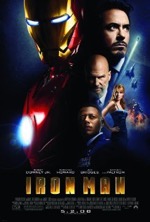
Starring: Robert Downey Jr.
May 2008
“Scrappy Hero Takes War on Terror to New Heights”
Let’s face it, in the history of dubious casting for superheroes, 42 year-old Robert Downey Jr. has to rank near the top, right? I mean, picking George Clooney to play Batman would seem less risky and more of a natural fit. Oh wait, Clooney did play Batman (and even with an abysmal script I still think he filled the cowl more adequately than Kilmer, which was another casting head-scratcher).
So go ahead and admit it. I’m sure you, like me, were more than just a little surprised when you first heard that Downey Jr. had been tapped to play the mechanized Marvel mainstay. Still, no one is more surprised, or grateful, to be playing billionaire playboy Tony Stark, and his titanium plated alter-ego, than Downey Jr. himself. “I never thought I’d have a shot at doing something like this because of my past,” Downey Jr. shared with Empire (Apr. 08). That brand of humility stands in…er, stark contrast to Downey Jr’s character, the Bill Gates of weapons manufacturing who exudes supreme confidence in his abilities, but whose flippant manner, irreverent attitude and self-absorption relegates him to a life of isolation, bereft of friendship save for his loyal assistant, Pepper Potts (Gwyneth Paltrow).
Following a successful demonstration of his newly designed Jericho missile in the deserts of Afghanistan, Stark’s motorcade of military Humvees is ambushed. As he runs for cover, a piece of shrapnel impales Stark in the chest. Black out. Waking inside a cave, Stark finds a circular electromagnetic device in his chest, which is keeping the metal fragments from working their way toward his heart. The device is powered by a car battery. But don’t worry, the battery doesn’t run out of juice before Stark creates an implant from odds and ends provided by his terrorist captors. Using these same scraps, the terrorists order Stark to build a Jericho missile from memory and scratch, but they’re a little slow in figuring out that what Stark is forging isn’t a WMD, but a body suit wrought from iron. Funny how the two could be so easily confused! Stark/Iron Man Mk. I plows his way through terrorists, destroys their camp (which, ironically, contains many of Stark’s munitions) and is rescued from the desert heat by conveniently placed helicopters, commanded by Stark’s military pal, Col. Rhodes (Terrence Howard).
And so we have Iron Man’s origins tale. Well, not quite…I left out the villain. Obadiah Stane, right-hand man of Stark’s deceased father, was slighted when Stark came of age and rightfully took over Stark Industries. When he catches wind of Stark’s next great breakthrough, Stane builds a Hulk-sized version of Stark’s body armor and dubs it Iron Monger. Admittedly, some of this is a bit silly; like how they can create these exorbitantly expensive suits seemingly on demand. Though Stane’s lecture to Stark during the climactic melee is patently hackneyed, Stane is actually a decent adversary, largely because he has motive, usurping Stark’s authority and notoriety, and means, undermining Stark’s interests and using Stark’s own billions against him. Armed with a distinctly resonant baritone voice (which you can hear lauding the dependability of Duracell batteries on TV ads) and an impressively wide acting range, Bridges’ Stane is a plausible antagonist because he’s the first villain in recent memory that isn’t insane, mad-at-the-world, given to grandiose speeches, needlessly narcissistic or downright inane.
I used the word “plausible” because it’s one of director Jon Favreau’s (Zathura) watchwords for his film. Favreau told Empire, “There are so many superhero movies now, how do you differentiate yourself?” Well, plausibility for one; but a slick-looking red and gold armor suit and high-end FX doesn’t hurt either. There’s plenty of hi-tech eye candy in the film, like the high-speed game of cat-and-mouse between two F-22 Raptors and our eponymous hero, but there are actually very few (compared to other recent superhero flicks) battle scenes: I’d say the ratio is 70% story and 30% action. An army of eight writers hashed out the story and screenplay, and that melting pot of scribes has created an accessible hero, a believable villain and a storyline ripped from today’s headlines. Thankfully, the movie’s political commentary is treated even-handedly, and in the post-9/11 world, Iron Man has become the very personification of our hopes for a terror-free world. The first big screen appearance of this comic hero couldn’t be timelier.
Favreau has crafted taut action scenes and tight dramatic segues, like the skillfully nuanced non-romance between Stark and Potts; can’t wait to see what happens to their relationship in the sequel. Yes, sequel! The way I see it, the only way this doesn’t become a franchise is if Iron Man runs into Magneto in the next film. Canned Stark!
Rating: 3
The Forbidden Kingdom (PG-13)
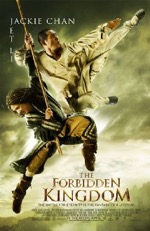
Starring: Jackie Chan
April 2008
“No Tigers or Dragons in Li and Chan’s Kingdom”
Kung Fu movie fanatic, Jason (Michael Angarano), visits his neighborhood video store to feed his habit. While perusing the video shelves, something in the back room catches Jason’s eyes—the curious teen discovers an ancient bow staff which the store’s doting, Asian proprietor explains will someday be returned to its rightful owner. Just then, a gang holds up the store. Picking up the carven staff to defend himself, Jason is instantaneously transported back in time to an alternate past in the Orient.
Though essential to the story, the time travel element causes a multitude of discrepancies, not the least of which is how a teen from present day Boston can understand and apparently speak ancient Chinese. Another problem is the anthropomorphic dialogue; many of the movie’s contemporary lines make no attempt at sounding period-appropriate, whatsoever. But no matter, we can forgive such gaffes and even suspend our disbelief to accept the existence of a Jade Warlord or a Monkey King or even the Gate of No Gate (easily the silliest name for a time portal I’ve ever heard) for the sake of the movie’s innovative, beautifully choreographed fight sequences. Keeping one foot firmly planted on the ground with the other hovering in the mystical air of supernatural films like Crouching Tiger, Hidden Dragon, the magic employed by the immortal characters in The Forbidden Kingdom is an Eastern fusion of Harry Potter-style incantations and Jedi-like energy manipulation.
Putting aside these niggling details, director Ron Minkoff’s martial arts showcase has many components that work like...er, magic. Besides John Fusco’s well-executed script and the spirited performances by Jet Li and Jackie Chan, the film’s technical elements distinguish The Forbidden Kingdom from other melee-centric Asian action films—this movie puts the art in martial arts. Still, even with excellent location work, finely crafted props, sets and costumes and sweeping cinematography, The Forbidden Kingdom’s production values still fall short of those featured in the multiple Oscar-winning Memoirs of a Geisha…but it’s a valiant effort just the same.
The Forbidden Kingdom will never be found on a martial arts top ten list, which is probably the film’s greatest asset. Not nearly as raw or graphic as the champs of the chop-socky genre, The Forbidden Kingdom could be classified as a family film if not for its action violence. And, with its coming of age, bully avenging narrative the film could be classified as the new millennium’s version of The Karate Kid. Mr. Miyagi would be proud!
Rating: 3
Leatherheads (PG-13)
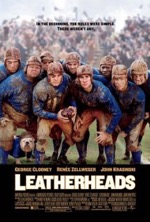
Starring: George Clooney
April 2008
“Screwball Football Farce Reveals Clooney’s Looney Side”
George Clooney’s budding romance with period pieces has blossomed into a love affair in Leatherheads, a comedic look at the early days of professional football, circa 1925. Before rules and regulations “ruined” the game, the players were much more colorful and simply played for love of the game. The money and crowds were as insubstantial as their padding and helmets, but the price was well worth the sacrifice, especially when the alternative was working in the factory, field or mine.
Moving up to the pros was also an outlet for college standouts that refused to hang up their pads after graduation. Such is the case for dashing Princeton running back, Carter “The Bullet” Rutheford (John Krasinski), who’s conscripted by charismatic Dodge Connolly (Clooney) to play for his Duluth Bulldogs. Carter, a war hero of Sergeant York proportions, appears on billboards and stadium advertisements throughout the country. Dodge hopes that such celebrity and visibility will help reinvigorate his failing sport.
On his quest to legitimize pro football, Dodge meets Lexie Littleton (Renee Zellweger), a spitfire news reporter for the Tribune who’s following a lead that will expose Carter’s heroic war story as a hoax. The ensuing love/hate relationship between Dodge and Lexie features some of the finest rapid-fire dialogue to grace a film in recent years. There are numerous scenes where the couple’s spirited bickering takes center stage and almost makes us forget we’re watching a football movie—especially during the passionate argument in Lexie’s cabin, a throwback to Cary Grant and Eva Marie Saint’s tryst on a train in Hitchcock’s classic North By Northwest. Though the movie’s middle chapters are addled by slow pacing, there are several amusing subplots that help keep the film on track: a love triangle forms between Dodge, Lexie and Carter, Dodge and Lexie evade a Keystone Cop-like police pursuit and Dodge and Carter engage in a gentleman’s fistfight where each man itemizes injured areas for the other to avoid.
The climactic game pits dotting Dodge against former teammate Carter on a muddy field in Chicago. The new commissioner’s edict that the contest be played without Dodge’s usual on-field antics forces the aging player to use all of his ingenuity in drawing up a game-winning play. Taking a cue from Carter’s grossly exaggerated war record, Dodge dubs the play the “Sergeant York.” The unconventional, yet not entirely illegal, play caps a slobber-knocker contest and a wildly entertaining film.
Leatherheads is classic comedy told on a timeless canvas, bolstered by directorial panache and acting acumen. Above all, it’s good old-fashioned filmmaking that pays fitting tribute to Hollywood’s Golden Age.
Rating: 3
Horton Hears a Who! (G)
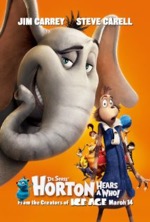
Starring: Jim Carrey
March 2008
“Horton Hears a Heavy-handed Whovie”
Somewhere along the way we stopped requiring movie stars to play characters and simply allowed them to play themselves. Here we have two comedy czars, Jim Carrey and Steve Carell, voicing characters that are so distinctly them; they’ve given typecasting a bad name. The detrimental drawback to this star-centric model is that it prevents the audience from discovering the characters on their own. Here we have Horton the elephant (Carrey), who finds a speck containing a diminutive civilization of Whos, and the mayor (Carell) of that tiny village known as Whoville (not to be confused with the other Whoville in How the Grinch Stole Christmas). Despite the fact that we never see the actors’ faces, Dr. Seuss’ Horton Hears a Who! is nothing more than The Carrey and Carell Show—very little originality gets past their blockade of manic antics and slapstick silliness.
The story is well-known from Seuss’ children’s book and the 1970 animated TV special narrated by Hans Conried. With its homily on the dangers of intolerance, personified by a rigid, rule-enforcing kangaroo (voiced with great effect by Carol Burnett), the story is more timely and relevant than ever. It’s also more politically charged than ever thanks to growing unrest and increasing polarization in our country. But should politics be mentioned in the same breath as an animated kids flick?
In the movie, the citizens of Whoville undergo radical climate shifts as Horton transports them to their new home; a secluded cave atop a nearby mountain. There, the Whos will be safe for all time…or at least until the bear returns for hibernation. There’s a thinly veiled reference to global warming (now known as “climate change” since the Earth is currently experiencing a cooling trend) in reverse when morning frost on the speck turns Whoville into an arctic waste. It’s profoundly unfortunate that this feel-good family film was ruined by insidious agendas from environmental alarmists and social nannyists. Granted, there’s a positive message in the movie’s most memorable mantra, “A person’s a person, no matter how small,” but it’s just so much stilted sermonizing made all the more unpalatable by force-fed moralizing and in-your-face patronizing.
The CGI is startlingly photo-realistic and the overall aesthetic is vintage Seuss, but the movie’s creative elements are overshadowed by its heavy-handed plot in much the same way that the story is held hostage by its larger-than-life stars. In the end, this isn’t a terrible film, but it isn’t the royal treatment that Seuss’ timeless tale deserves. But kids will love it, and when all is said and done that’s all that really matters.
Rating: 2 1/2
10,000 BC (PG-13)
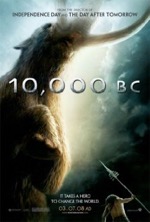
Starring: Camilla Belle
March 2008
“Woolly Wonka and the Raiders from Early Egypt”
When Roland Emmerich, director of such mega-blockbusters as Independence Day and The Day After Tomorrow, decided to do a historical adventure he really rolled back the calendar. Based on sketchy historical evidence, wild suppositions and mammoth-sized leaps of logic, 10,000 BC tells a simple, straightforward tale of courage, passion, rivalry and prophecy with dreadlocks and loincloths to boot.
The movie opens with a scene-setting narration by Omar Sharif, which introduces the main players—blue-eyed ingénue Evolet (Camilla Belle) and brash hunter D’Leh (Steven Strait), childhood friends turned adult lovers—their mountaintop village and their plight; shrinking mammoth populations threaten to bring on starvation and the much feared “last hunt.” The story heats up when the four-legged demons (proto-Egyptian slavers) raid the camp and carry off Evolet and many other villagers. Tribal elder Tic’Tic (Cliff Curtis), D’Leh, and two other tribesmen embark on a harrowing rescue mission—complete with narrow escapes, chance encounters and the occasional evisceration by a prehistoric ostrich—in order to retrieve their friends and loved ones.
With 10,000 BC, Emmerich and co-writer Harald Kloser have found the secret to being predictable without being boring. Of course, love him or hate him, boring is not a word generally associated with Emmerich or his films. Besides breathtaking cinematography (shot in South Africa, New Zealand, Thailand and Namibia) of snowcapped mountain ranges, sweltering jungles, tall grasslands and gorgeous desert vistas that would make director David Lean (Lawrence of Arabia) drool, the movie’s effects-laden action sequences are undoubtedly the movie’s cornerstone. Let’s face it, without the action scenes the movie, with its no-name cast, alternate-history lesson, contrived storyline and monosyllabic dialogue, wouldn’t have amounted to very much.
It’s reported (Empire/March, 08) that the animal animation took two effects houses two years to complete. At one point, when rendering estimates exceeded the time remaining until the movie’s premier, Emmerich made the executive decision to reduce mammoth fur density by 50 percent. Despite this CG shearing, the mammoths look surprisingly respectable, mostly because their movements resemble present day pachyderms. The same cannot be said of the saber-toothed tigers which are embarrassingly fake-looking, both in appearance and movement. As far as feral felines are concerned, the film’s saber-toothed cats represent a significant regression from Narnia’s lion, Aslan, which had its own CG challenges. Fortunately, the ancient tigers only appear in a few scenes, and soon enough we’re back to watching the not-so-woolly mammoths stampeding down pyramid ramps, knocking off anyone or anything that gets in their way like massive, prehistoric bowling balls.
For all of its historical inaccuracies and screenplay shortcomings, 10,000 BC is a visual spectacle, pure and simple. Proudly showcasing breathtaking backgrounds, Emmerich gets it right when he uses real locations instead of CG ones (Lucas’ prequels suffered from the reverse). There’s something uniquely organic and exotic in Emmerich’s use of various locales in the film; each landscape—tundra, tropical, desert, etc.—serves to characterize the different climates while providing color, texture, atmosphere and, dare I say it, artistry.
Emmerich’s unbound imagination and unbridled vision have forged 10,000 BC into a unique viewing experience. However, when a sequel is excavated, let’s hope the writers find some semblance of a storyline for 9,990 BC. With any luck, that’s also the year the saber-toothed tiger became extinct.
Rating: 2
Vantage Point (PG-13)

Starring: Dennis Quaid
February 2008
“Do You See What I See…See…See?”
Four people standing on four corners of an intersection witness an accident. What does each one see?
I’m sure you’ve heard that hypothetical exercise in a philosophy or psychology class or perhaps in a riddle during a long road trip to help pass the time. It’s a simple illustration of a complex concept…point of view. The movie poster for Vantage Point succinctly spells out the movie’s premise while doubling the number of individuals in our example: 8 strangers, 8 points of view, 1 truth.
Vantage Point illustrates the subjectivity of viewpoint amid real world politics in our terror-wracked world. Freshman director, Pete Travis, says this about the movie’s intricate POV plot, “…our version of the truth depends on who we are and what perspective we’re viewing it from” (Empire, Feb 08). Like at the corner of an intersection.
The movie opens at an anti-terror summit in Salamanca, Spain, where the U. S. President (William Hurt) is set to deliver a rousing speech to a capacity crowd. As he approaches the podium, the President is shot by a sniper. Pandemonium erupts in the teeming square as panicked spectators flee the vicinity en masse. Then a bomb explodes and bodies rain down all over the courtyard. By the time the dust settles, we’ve got ourselves a whopper of a whodunit with frenetic, energetic action scenes and loads of political intrigue to spare.
However, the taut plot’s Achilles Heel is that the story rewinds five times to the same moment (twenty-three minutes before the assassination) and shows the same sequence of events but from different perspectives and, if we’re lucky, different angles. Useful for filling in the back story and gradually revealing more pieces to the puzzle, the movie’s repetition may prove exhausting to some, judging from the groans I heard each time the movie’s rewind button was engaged. However, writer Barry Levy deserves credit for delivering an intense and intelligent actioner with a Rashomon style plot device that bears up well under scrutiny while providing edge-of-your-seat exhilaration.
The movie’s A-list actors also deserve a shout out here. Sigourney Weaver, who plays a news journalist, does excellent work in a limited role—she only appears in the first act. Dennis Quaid and Matthew Fox are secret service agents. Quaid, who previously took a bullet for the president, is restive and a bit paranoid. Fox, on the other hand, is conspicuously calm during the movie’s tragic events. Forest Whitaker, in a superb turn as the innocent bystander who captures a glimpse of the assassin on his camcorder, is the emotional anchor in the movie and shines in the scenes where he tries to help a little girl find her mother among the stampeding throng.
Vantage Point is a good film, but with more experience at the helm and less redundancy in the non-linear story, it could have been great. Still, Vantage Point is an action-packed thrill ride that starts off in high gear, accelerates through the Bourne-like car chase and hits maximum velocity during the twisty, heart-stopping climax.
Final thought: If you find yourself needing a break from the repetitive storyline, don’t hesitate to get up and refill your popcorn. If you time it right, you can return to your seat at the same exact moment you left.
Rating: 3
Definitely, Maybe (PG-13)
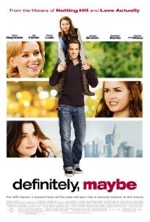
Starring: Ryan Reynolds
February 2008
“You Must Choose, But Choose Wisely!”
Premise:
A father tells his inquisitive daughter the story of how he met her mother.
Synopsis:
When the usual bedtime story fails to captivate precocious preteen, Mya (Abigail Breslin), she coerces her father, Will (Ryan Reynolds), into regaling the story of how he fell in love with her mother. The movie unspools in a series of flashback vignettes which introduce us to three of Will’s old flames: Emily (Elizabeth Banks), April (Isla Fisher) and Summer (Rachel Weisz). Will renames the women to make his story more of a mystery, but Mya, obviously, knows who her mother is. However, one of the movie’s inherent thrills is that we in the audience are kept guessing who mommy is until the very end, and even then, there’s a significant twist before the movie fades to black.
Creative Contributions:
Looking at the film from a production standpoint, the first thing that stands out is the remarkable cast. Breslin is her normal, adorable self, but it’s Reynolds who steals the show with his disarming sarcasm and charming brand of helplessness. Will’s three, pitch-perfect paramours are simply smoking, especially Weisz, who’s come a long way from the geeky librarian in The Mummy. Honorable mention (and Oscar consideration) goes to Kevin Kline for his colorful portrayal of book-writing boozer, Hampton Roth. Hampton’s torrid love affair with his student, Summer, takes a strange twist when she falls in love with Will; the ensuing love triangle further muddies the waters with respect to Will’s ultimate choice for a mate. Besides relational matters, the movie’s political commentary is also engaging. Overly idealistic and highly opinionated Will starts off as a lackey at Bill Clinton’s campaign headquarters and eventually works his way up to a power position by the president’s second term. Will’s progression from ambitious upstart to disillusioned sideliner makes for a fascinating character study.
Evaluation:
My initial reaction to the trailer for Definitely, Maybe was “Maybe, If I Must.” However, the film is a superior love story because it doesn’t constrain itself to the standard conventions of the genre: faux pas, awkward moments, startling revelations, relational gags, etc. The performances are all outstanding and writer/director Adam Brooks’ first-rate script is wildly entertaining and highly provocative—think of Definitely, Maybe as the perfect marriage between a chick flick and a Woody Allen dramedy. The end result here is far superior to other recent romance films and is definitely worth seeing.
Rating: 3
Fool's Gold (PG-13)
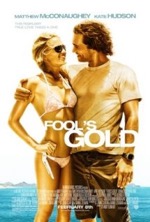
Starring: Matthew McConaughey
February 2008
“How to Lose an Audience in Ten Minutes”
The movie’s opening is quite clever: the wind sweeps up a piece of paper inside the main cabin of a yacht and fatefully carries it to the rear of the boat where it sets the sheet down on top of a struggling generator. Sparks from the generator set the paper on fire and soon the boat is ablaze. When the fire reaches a propane tank, the entire ship goes up in a fulminating inferno.
Ben “Finn” Finnegan (Matthew McConaughey) and his Ukranian sidekick, Alfonz, (Ewen Bremner) are searching for treasure on the ocean floor when pieces of the boat begin “raining down” on them. The ensuing underwater argument is amusing, and even though the story seems as shallow as the water Finn and his partner are swimming in, the scene actually marks the movie’s highpoint: like the sunken ship that descends to its watery grave, it’s all downhill from here.
After eight years of following her zealous husband around on one treasure hunt after the next, Tess (Kate Hudson) has decided to pull the plug on their marriage. When Finn arrives late to the divorce proceedings, he forfeits all of his possessions to Tess, including the boat that he just sent plummeting to the bottom of the sea. However, the boat’s sinking is serendipitous in a way; the ship’s impact on the ocean floor dredges up part of an ancient plate, which is the first clue to a nearby treasure.
You don’t need to be a fortuneteller to see where the story goes from here. Finding a fabled treasure, reconciling a failed marriage, staying one step ahead of competing treasure seekers (led by Moe, Finn’s former partner, played by Ray Winstone)…as they say, it’s all in the script. A simple and simpleminded script, the story spends far too much time on the expository history lesson, too much effort on the frenetic, freewheeling climax and not enough energy on fleshing out its characters.
McConaughey and Hudson, who were charming together in How to Loose a Guy in 10 Days, surprisingly have an utter lack of screen chemistry here…their relationship seems forced and unnatural. It’s almost like they’re trying too hard. The finest performance in the movie belongs to Donald Sutherland, who plays the wealthy boat owner that ferries the leads around on their treasure quest, most likely because he needs a diversion from dealing with his spoiled brat granddaughter, Gemma (Alexis Dziena).
Fool’s Gold is an unremarkable film that banks on its star power to please its audience. In the end, this rom-com/adventure movie more than lives up to its name: those who view it will find iron pyrite instead of pure gold. Don’t be fooled!
Rating: 2
Cloverfield (PG-13)
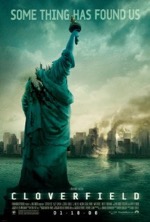
Starring: Mike Vogel
January 2008
“Standard Disaster Flick with Distracting, Nauseating Visuals”
The older I get the less I enjoy roller-coasters; these days it doesn’t take much for me to get motion sickness. As such, I seldom frequent amusement parks, but when I do, I know exactly what I’m getting myself into. With Cloverfield, the new J.J. Abrams-produced scare-fest, I went in expecting to see a movie but came out feeling like I’d just stepped off a roller-coaster, having experienced all of the side effects but none of the fun.
The easiest way to define Cloverfield is: The Blair Witch Project meets Godzilla. The entire film is shot from the POV of a single camcorder in a very shaky, jittery and wobbly fashion. After about fifteen minutes of handy-cam hell, I found it increasingly difficult to keep my popcorn from coming back up. I ended up closing my eyes to avoid hurling on the person in front of me, and, as strange as it seems, I still could follow the narrative with little difficulty. I guess rampaging creature movies are like baby’s butts: if you’ve seen one, you’ve seen them all.
The movie opens with a going away party thrown by Jason Hawkins for his brother, Robert, whose recent promotion will require him to relocate to Japan. We’re briefly introduced to Jason’s girlfriend, Lily, and his uncouth friend, Hud, (who becomes unwitting documentary director) before the “creature” makes its bombastic entrance, instantaneously transforming the streets of Manhattan into a horrific tableau of death, destruction and panic-ridden pandemonium. Evacuees, hoping to find safe haven on the other side of the Brooklyn Bridge, converge upon the structure en masse; but anyone who’s seen a Godzilla movie or the recent I Am Legend, will know instinctually that such an exit strategy will surely meet with an untimely demise.
Leaving no Godzilla convention untapped, the creature dispatches a platoon of youngling foot soldiers which are used like vacuum attachments—to clean up those hard-to-reach places. Oh, and speaking of plot contrivances; why is it that characters presented with a means of escape will invariably return to the danger zone to save someone or some thing? The most annoying example of this phenomenon I’ve ever seen—in any film—is when Sigourney Weaver’s Ripley leaves the safe confines of her spaceship and risks being eaten by an Alien to save her blasted cat (apologies to PETA). Here, the object of reckless abandon is a wounded woman, so I suppose the actions of the main characters are more heroic—if equally foolhardy.
Credit director Matt Reeves with delivering a highly experimental creature feature, even though the experiment is an ignominious failure of ironically gigantic proportions. Despite being financed by a major studio, Reeves’ attempt at creating the newest sensation in ultra-real entertainment comes off looking like a high-end home video…and I certainly wouldn’t have paid ten bucks to see that, had I known.
Scriptwriter, Drew Goddard, taking a cue from earlier disaster films like Titanic, skillfully ushers his characters through the movie’s earth-shattering events; a narrative device that’s used to personalize and humanize a tragedy while setting up a powerful payoff during a catastrophic climax. Unfortunately, that kind of emotional empathy doesn’t work for Cloverfield because character development is virtually non-existent from the word go. When one of the characters is imperiled, it’s like watching a stranger’s plight on the news; you might pity them, but if you don’t know who they are, it’s difficult to feel genuine sympathy for the individual.
Cloverfield weighs in at a lean eighty-five minutes, yet still manages to overstay its welcome due to its unrelenting, dizzying mode of filming. To say that Cloverfield—the beneficiary of an ingenious marketing campaign, stratospheric expectations and Herculean hype—is a massive disappointment would be a colossal understatement. However, even if the viewing experience had been a pleasant one, the dismal and abysmal story still would have ruined a film that’s more nauseating than it is frightening.
Many questions are left unanswered, like where does the creature come from? Or why, in the sprawling metropolis of NYC, does the creature always seem to be right on top of our heroes? Perhaps the biggest unanswered question is the significance of the title. It sounds cool, but what does it mean? There’s no reference to a Cloverfield anywhere in the movie. I suppose, however, that Cloverfield is acceptable as a euphemistic title since Herky-jerky wouldn’t have sold a single ticket.
Rating: 1 1/2
27 Dresses (PG-13)
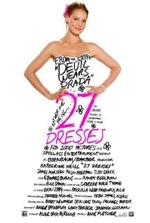
Starring: Katherine Heigl
January 2008
“Adorable Heigl Anchors Standard Rom-com”
Premise:
A woman who’s been a bridesmaid for twenty-seven friends longs for her own special day.
Synopsis:
People pleasing Jane Nichols (Kathryn Heigl) denies her own happiness even to the extent that she plans her sister’s wedding to the man she’s madly in love with.
Creative Contributions:
As would be expected, there are a lot of dresses in the movie. As such, the costuming is hard to ignore when evaluating the movie’s production virtues. Additionally, there are some nice locations and a few interesting sets, apart from the movie’s many wedding/reception venues. However, there’s little else to talk about below the line. As the movie’s central figure, Jane is an interesting character study in what it’s like to be a human welcome mat, and Heigl’s pitch-perfect performance anchors the movie in charming and meaningful ways. The movie’s perfect man, Kevin (James Marsden), is, ironically, a jaded newspaper columnist who would rather be thrown from a plane without a parachute than get hitched (he refers to marriage as “the last legal form of slavery”). Of course we all know he’s eventually going to come around and that Jane will be the catalyst to opening his eyes to new horizons of love, but the process of how Kevin succumbs to one of Cupid’s arrows is half the fun of the movie. It’s a difficult role that easily could have been knocked off course by a tidal wave of smarminess or insincerity, but Marsden pulls it off in surprising fashion…surprising when you place this turn next to his groan-inducing performances in the X-Men movies. They say you can’t catch lightning in the same bottle twice. You would’ve expected that tapping the writer of box-office smash and critical darling The Devil Wears Prada, Aline Brosh McKenna, would have guaranteed a surefire hit here. Unfortunately, the sum of its parts doesn’t even come close to capturing the same movie magic that Prada had in spades.
Evaluation:
27 Dresses is the old expression “Always a bridesmaid, never the bride” on speed. It’s a diverting, if overstated, look at how a cynical man and weak willed woman can fall in love and live happily ever after, and is, therefore, a modern fairy tale. Even though it’s as predictable as every other romantic comedy out there, 27 Dresses does feature a unique take on love and marriage and also has some engaging performances. In short, you should take in 27 Dresses.
Rating: 2 1/2
The Bucket List (PG-13)
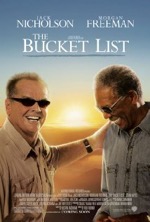
Starring: Jack Nicholson
January 2008
“Kickin’ It with Nicholson and Freeman”
Car mechanic, Carter Chambers (Morgan Freeman), is laid up in a hospital. He has cancer. The fussy old crank in the bed next to Carter is also a cancer victim and just happens to be the owner of the hospital, Edward Cole (Jack Nicholson). Edward makes incessant demands of nurses and his personal assistant Thomas (Sean Hayes). He also has gourmet feasts prepared for him and frequently turns up his nose at some portion of the meal. Carter should be so lucky…his feast is bland hospital food.
Faced with a similar demise, Edward and Carter band together against their mutual enemy like two soldiers in a foxhole. Such commonality provides the basis for a budding friendship which comes full bloom in time, but not before Edward finds a crumpled up piece of paper on the floor that contains Carter’s bucket list. Simply put, the bucket list is an itemization of all the things an individual hopes to accomplish before he kicks the bucket.
At first, Edward is amused by the quaint concept but then buys into the idea wholesale when his doctor delivers the devastating news…Edward and Carter both have six months to live. After being released from the hospital, the geriatric gents set out on a journey of reckless abandon and personal discovery…all financed by Edward’s billions.
The first item on the list: hold a big gun on a safari. Next up: skydiving! Other items: race a car, get a tattoo and go to India. The more items they check off the list, the more Edward and Carter realize that gallivanting around the globe is only prolonging the inevitable; both must return home to make restitution with estranged family members.
Justin Zackham’s excellent script gives the story wings, but it’s the superlative performances that make it fly. Nicholson and Freeman, an unlikely pairing, bring out the best in each other like iron sharpening iron. Impressive filmographies and multiple Oscars aside, the big screen veterans infuse their roles with dignity in the face of finality.
One wonders how much actual direction veteran auteur Rob Reiner gave his legendary leads. Was he hands-on or did he just wind up his two stars and turn them loose to do what they do best…sell tickets and entertain audiences? Either way, Reiner’s well-honed craft is manifest in every frame, especially in the intimate character vignettes.
Some will judge The Bucket List as an overly sentimental debacle, whose stilted carpe diem homily shamelessly tugs at the heartstrings. Whereas I acknowledge the validity of that viewpoint, I see the film as an uplifting, life-affirming guide on how to go out with a bang. And really, is there any harm done in being reminded to take stock of one’s life or to make the most of every moment? Seize the day before you seize up!
Rating: 3